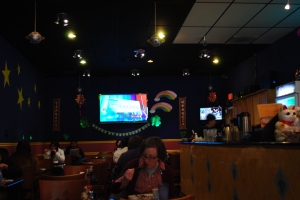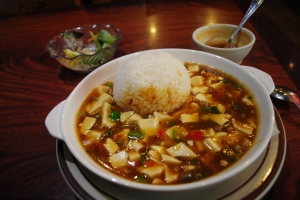The three-story building on the corner of Webster and 9th street sits empty in the heart of Oakland’s Chinatown. As recently as four months ago this was a successful restaurant and cultural institution, but now the only remnant of that is a single round sign that reads Silver Dragon.
Directly across the street is the Pacific Renaissance Plaza that housed what used to be ABC Bakery, another defunct Chinatown favorite.
Kitty–corner on 9th street, the ironically named New Idea restaurant occupies a two-story building, which opened after another iconic restaurant, King Wah, closed and longtime owner Jim Hooi retired.
The more recent closings of these Chinatown staples illustrate how much the neighborhood is struggling right now. And forms the perfect parallel to what is happening in Chinatown as a whole.
Chinatown is aging, and isn’t getting any new blood to replace the old. The aging effect is the most noticeable in the residents.

This chart shows the difference in age breakdowns of Chinatown in 2000 and 2010
According to the 2010 U.S. census data, of the more than 2700 residents living in Chinatown 52.1 percent of them are over the age of 60. Which is due to the numerous amounts of senior living homes in the area.
“We have a lot of senior citizens in the area so we need to have low income housing or senior housing,” said Darlene Lee, recreation leader of the Lincoln Square recreation center. “And that’s great, but they don’t have enough money to support the area by themselves.”
Individuals have lived in Chinatown their whole life, the only problem is that they are growing older and newer generations aren’t coming in to replace them.
“Younger people usually want to live around people similar to them,” said Jack London Square realtor Forrest Gee.
Since the bulk of residents in Chinatown are seniors the housing panders to that demographic which turns off younger people.
“The models here [in Pacific Renaissance Plaza] are very low amenities,” Gee said. “Younger people want gyms, or hot tubs or pools but we don’t have that because that’s not important to seniors.”
According to the U.S. census the median age of Oakland’s Chinatown residents have risen from 57.1 to 61.2 in the last 10 years.
The mostly elderly population is hurting the restaurants and businesses economically as the aged residents are less apt to go out for lunch and dinner.
“Chinatown is struggling,” said Jennie Ong, executive director of the Oakland Chinatown chamber of commerce. “You can tell because vacancy rates are up and before vacancy rates were unheard of in Chinatown.”
They also have less money to go out and support the local establishments. Not only that but their preference in food has caused once successful restaurants to close due to dwindling clientele.
“For institutions like Silver Dragon and King Wah, it was a combination of the slowing local economy and their unique Cantonese American style comfort food,” director of Oakland Chinatown oral history project Roy Chan said. “ That more catered to older generations of immigrants and their descendants.”
The younger people that do move into Chinatown often work elsewhere, so they support the establishments around their work, whereas Chinatown serves only as a place to sleep.


The real question is, with the family values so synonymous with Chinatown, why aren’t newer generations following their elders and moving into the neighborhood.
Darlene Lee thinks it has to do with the negative connotations of the word Chinatown.
“People [that] come from somewhere else and have a different lifestyle do have a bad connotation of Chinatown,” Lee said. “They think it’s more like a ghetto or that we are bumpkins.”
Lee also said that people feel like Chinatown is more a rundown neighborhood and because of that, they feel less inclined to spend their money there than more upscale places.
Not only that but a lot of residential space is being pushed out by housing for the Lake Merritt BART station and housing for Laney College.
Without people both living and working in Chinatown, the restaurants and businesses are forced to depend on tourism to stay afloat.
The only problem with that is that it isn’t a tourist destination.
“Many people don’t even know we have a Chinatown here in Oakland.” Darlene Lee said. “We also have parking problems, whereas if you go to the mall you don’t have to pay for parking. It could add up to an extra $10, that’s one less dish you can order.”
When people do make it out to Chinatown, they end up spending money there; the problem is bringing people to the area in the first place.
“What I’ve noticed is when people come here for dancing or tai chi they support Chinatown,” Lee said. “After they are done they go eat dim sum or lunch then do a little shopping and then go home.”
In order for Chinatown to prosper once again, it must do something to draw in the average person.
As sacrilegious as it sounds, it has to look at what San Francisco’s Chinatown is, and embrace tourism. Or at least market itself like San Francisco.
“I think we need to market Chinatown, need to market its amenities,” Ong said. “That’s something the city of Oakland has never done, hopefully with Jean Quan as a mayor she will understand that.”
Also what happens with the area surrounding the Lake Merritt BART station will greatly influence Chinatown’s future. BART is going ahead with a plan to double Chinatown’s population by creating market rate housing.
“Our only hope is the Lake Merritt BART station and how it’s going to be developed,” Ong said. “We are looking toward market rate housing and new commerce out there, because when you’re near transportation it’s usually very expensive.”
The neighborhood has shown in the past that it can halt its own decline.
When it started out Chinatown was only four blocks and was really struggling in the 1950s. But an influx of immigrants brought Chinatown newfound life and turned it into the roughly a 35-block square that it is today.
It adapted, and that’s exactly what it has to do now.
“We don’t need to turn to the past because it was a struggle for everyone growing up,” Lee said. “In order for Chinatown to really blossom again we have to do something really outrageous. We have to make it a place that you want to go to, we need to change the whole dynamic of Chinatown.”









